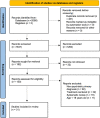Heart Rate Variability in Psychiatric Disorders: A Systematic Review
- PMID: 37881808
- PMCID: PMC10596135
- DOI: 10.2147/NDT.S429592
Heart Rate Variability in Psychiatric Disorders: A Systematic Review
Abstract
Introduction: Heart rate variability (HRV) is a measure of the fluctuation in time interval between consecutive heart beats. Decreased heart rate variability has been shown to have associations with autonomic dysfunction in psychiatric conditions such as depression, substance abuse, anxiety, and schizophrenia, although its use as a prognostic tool remains highly debated. This study aims to review the current literature on heart rate variability as a diagnostic and prognostic tool in psychiatric populations.
Methods: A literature search was conducted using the MEDLINE, EMBASE, Cochrane, and PsycINFO libraries to identify full-text studies involving adult psychiatric populations that reported HRV measurements. From 1647 originally identified, 31 studies were narrowed down through an abstract and full-text screen. Studies were excluded if they enrolled adolescents or children, used animal models, enrolled patients with another primary diagnosis other than psychiatric as outlined by the diagnostic and statistical manual of mental disorders (DSM) V, or if they assessed HRV in the context of treatment rather than diagnosis. Study quality assessment was conducted using a modified Downs and Blacks quality assessment tool for observational rather than interventional studies. Data were reported in four tables: 1) summarizing study characteristics, 2) methods of HRV detection, 3) key findings and statistics, and 4) quality assessment.
Results: There is significant variability between studies in their methodology of recording as well as reporting HRV, which makes it difficult to meaningfully interpret data that is clinically applicable due to the presence of significant bias in existing studies. The presence of an association between HRV and the severity of various psychiatric disorders, however, remains promising.
Conclusion: Future studies should be done to further explore how HRV parameters may be used to enhance the diagnosis and prognosis of several psychiatric disorders.
Keywords: digital health; heart rate variability; psychiatry.
© 2023 Ramesh et al.
Conflict of interest statement
The authors report no conflicts of interest in this work.
Figures


Similar articles
-
Systematic reviews of the effectiveness of day care for people with severe mental disorders: (1) acute day hospital versus admission; (2) vocational rehabilitation; (3) day hospital versus outpatient care.Health Technol Assess. 2001;5(21):1-75. doi: 10.3310/hta5210. Health Technol Assess. 2001. PMID: 11532238 Review.
-
[Heart and brain -- the influence of psychiatric disorders and their therapy on the heart rate variability].Fortschr Neurol Psychiatr. 2005 Apr;73(4):192-205. doi: 10.1055/s-2004-830109. Fortschr Neurol Psychiatr. 2005. PMID: 15806437 Review. German.
-
Heart rate variability (HRV) as a way to understand associations between the autonomic nervous system (ANS) and affective states: A critical review of the literature.Int J Psychophysiol. 2023 Oct;192:35-42. doi: 10.1016/j.ijpsycho.2023.08.001. Epub 2023 Aug 3. Int J Psychophysiol. 2023. PMID: 37543289 Review.
-
Different Clinical Expression of Anxiety Disorders in Children and Adolescents: Assessment and Treatment.Pril (Makedon Akad Nauk Umet Odd Med Nauki). 2019 May 1;40(1):5-40. doi: 10.2478/prilozi-2019-0001. Pril (Makedon Akad Nauk Umet Odd Med Nauki). 2019. PMID: 31152643
-
Heart rate variability in patients with cirrhosis: a systematic review and meta-analysis.Physiol Meas. 2021 Jun 17;42(5). doi: 10.1088/1361-6579/abf888. Physiol Meas. 2021. PMID: 33857926
Cited by
-
Interactions Between Depression, Autonomic Dysfunction, Inhibitory Control and Reaction Time: Insights From Heart Rate Variability During Continuous Performance Test.Psychiatry Investig. 2025 Aug;22(8):921-929. doi: 10.30773/pi.2025.0043. Epub 2025 Aug 5. Psychiatry Investig. 2025. PMID: 40754941 Free PMC article.
-
Changes in Negative Emotions Across Five Weeks of HRV Biofeedback Intervention were Mediated by Changes in Resting Heart Rate Variability.Appl Psychophysiol Biofeedback. 2025 Mar;50(1):25-48. doi: 10.1007/s10484-024-09674-x. Epub 2024 Nov 8. Appl Psychophysiol Biofeedback. 2025. PMID: 39516353 Free PMC article. Clinical Trial.
-
Inter- and Intrapersonal Associations Between Physiology and Mental Health: A Longitudinal Study Using Wearables and Mental Health Surveys.J Med Internet Res. 2025 Jul 23;27:e64955. doi: 10.2196/64955. J Med Internet Res. 2025. PMID: 40700646 Free PMC article.
-
Heart Rate Variability and Interoception in Periodic Limb Movements in Sleep: Interference with Psychiatric Disorders?J Clin Med. 2024 Oct 14;13(20):6129. doi: 10.3390/jcm13206129. J Clin Med. 2024. PMID: 39458079 Free PMC article. Review.
-
Machine Learning Prediction of Attachment Type From Bio-Psychological Factors in Patients With Depression.Psychiatry Investig. 2025 Apr;22(4):412-423. doi: 10.30773/pi.2024.0392. Epub 2025 Apr 11. Psychiatry Investig. 2025. PMID: 40262791 Free PMC article.
References
-
- Costa T, Hill S, Taylor A, Green A, Black F, Watson S. autonomic dysregulation in individuals with psychiatric disorders and healthy. BJPsych Open. 2022;8(Suppl 1):186. doi:10.1192/bjo.2022.186 - DOI
-
- Electrophysiology TFOTESOCTNA. heart rate variability: standards of measurement, physiological interpretation and clinical use. Task force of the European society of cardiology and the North American Society of Pacing and Electrophysiology. Circulation. 1996;93(5):1043–1065. doi:10.1161/01.CIR.93.5.1043 - DOI - PubMed
Publication types
LinkOut - more resources
Full Text Sources

